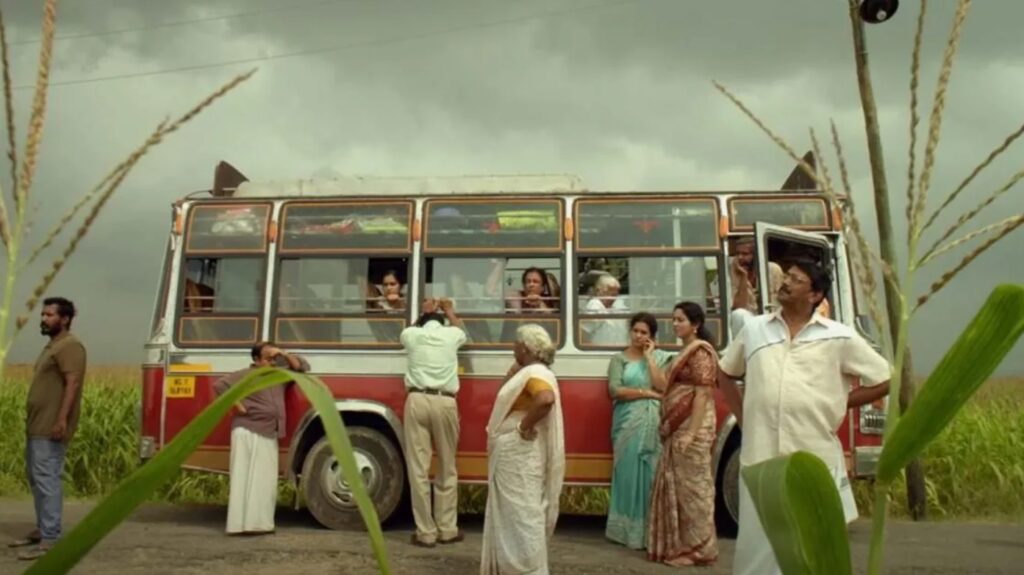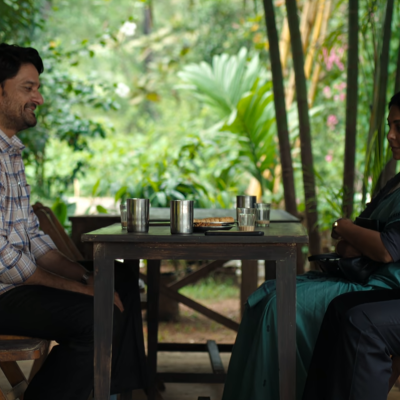Have you ever experienced waking up from an afternoon nap just before the golden hour, feeling momentarily disoriented as if you’ve stumbled into a different world, a different time, even a different persona? I’m sure it did! Now, take that feeling a little further, a little LJP-esque (Lijo Jose Pellissery), where upon waking, you’re not just momentarily confused but genuinely convinced you’re someone else entirely and you start behaving like that person.
That’s “Nanpakal Nerathu Mayakkam” for you under 100 words.

The film follows a man who wakes up believing himself to be a completely different person from a bygone era after a nap during a journey home from a pilgrimage. As his bewildering and frolicky behaviour unfolds, both his own family and that of the person he imagines himself to be must grapple with the repercussions, a spectacle worth witnessing for yourselves.
Knowing LJP’s works and what he can achieve with almost every genre, I should have watched it when it was released almost a year ago. But regrettably, I just dillydallied and almost forgot when one of my friends and a fellow cinephile, Sandeep (from Ukiyo) rated it as his favourite among LJP’s films! Yes, even above Ee.Ma.Yau!!! Could you imagine? So, I thought of immediately watching it and saying, “Hey dude! This Nanpakal thing-y is good but not better, especially not above EMY! So, stop chumma blabbering something or the other!!!”
But I couldn’t say that because he was almost right. It sparked a debate in my mind about whether it surpasses even the acclaimed “Ee.Ma.Yau.”, which I consider LJP’s best work yet. NNM might actually have a little edge because LJP pulled it off with Mammukka, who is one of the biggest names in Malayalam cinema, with such conviction when the former had everything to lose.
This is one of those movies which need not necessarily have ‘creative’ camera angles or the music might not be as ‘evocative’ as you might usually experience or it might not have the best ‘colour grading’. But this movie is so beautifully shot that the staging of cameras almost feels non-existent in this quiet village. It had the 70s Tamil cinema songs and dialogues playing in the background almost throughout the film which added depth to the characters’ emotions. The colour grading was enough to get the essence of a green bitter-guard orchid and pale cow-grazing hay.

This movie was so beautifully intertwined with the perpetual movie dialogues murmuring in the background from an old portable TV set that became a character of its own which created a rich tapestry of subconscious thoughts of the people in the movie. Certain sections of the movie might feel a bit drawn out, like a full one-minute scene of the bus driving with songs playing in the background with never-ending panoramic views of the outdoors and wavering engine sound. If that scene made you sleepy, then the purpose was served as it underscores the monotony of daily life. LJP, I think, wanted to prove if a viewer can fall asleep then so do the characters in the movie who are on the bus. There were many such situations that seemed a little too stretched at first but were justified properly by the time the film ended.
“Death is sinking into slumbers deep, birth again is waking out of sleep.”
Thirukkural
When James (Mammooty) became Sundaram and was supposedly having his usual routine of the day, chatting with some people, asking money from the revenue officer, having tea at Manikam’s, or delivering milk to various akkas in the village – this was all horror for the James’ family and Sundaram’s because he was not James to go back to the bus nor was Sundaram to stay at the village. It had that Ee.Ma.Yau style of comedy blended well with the underlying themes of existentialism and societal norms. The village was quiet and mellow yet something extraordinary and horrific was going on in that passive part of the country. The person who is responsible for such havoc was having a good time smoking beedi and drinking desi sarakku (alcohol) whilst enacting the whole of Sivaji Ganeshan’s dialogues from the 1973 film, Gauravam. He was roaming the village carefree while the villagers and the outsiders were chasing him to stop and ‘come to senses’. It was both entertaining and thought-provoking to watch this unravel layer-by-layer. This whole pandemonium strongly resembles the characters from Adoor Gopalakrishnan, isn’t it?
Aah! YES! IT INDEED HAD THE FLAVOUR OF ADOOR GOPALAKRISHNAN MOVIES, where characters find solace in their own delusions despite the harsh realities surrounding them. Watch Elippathayam, for instance. Even when the world around the protagonist’s character is crumbling with poverty, radicalism, and helplessness; the male character is just worried about the rat hiding in the attic. Such was Sundaram in NNM and that’s how Lijo made the film. It’s a testament to his directorial prowess that he can seamlessly blend such disparate elements into a cohesive and compelling narrative.

It was Lijo who took an afternoon much-needed power nap and woke up to be and think like the Great Adoor Gopalakrishnan!
Go watch this movie ASAP, if haven’t already and read the second part of the article that contains my interpretation and detailing of certain sections of the movie. It’s an experience you’ll never forget.




